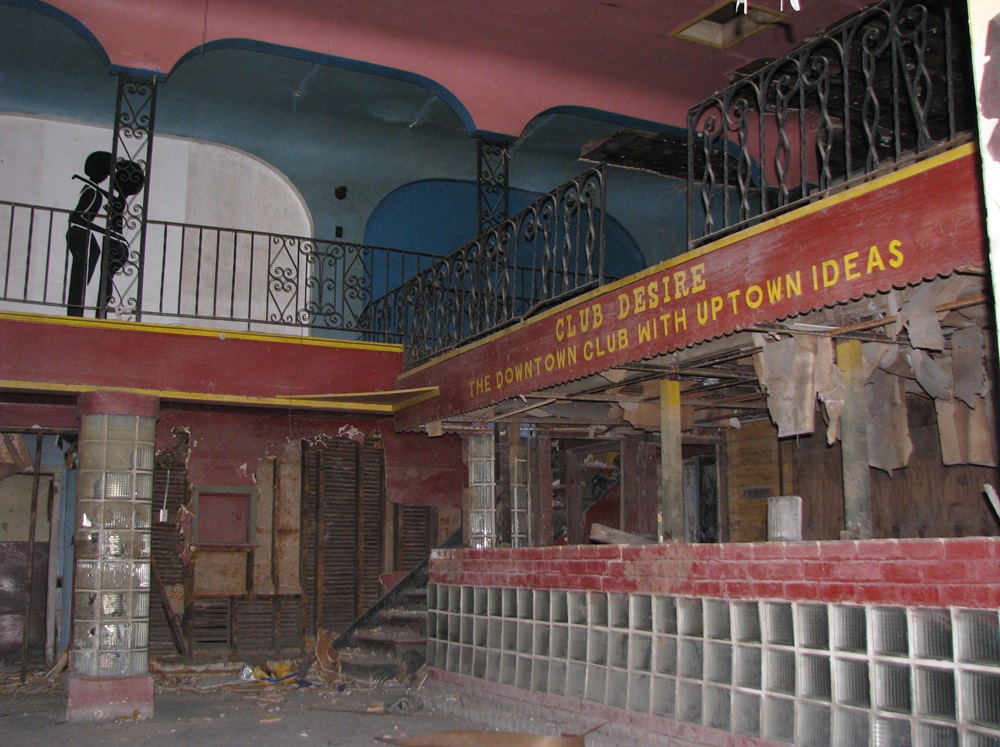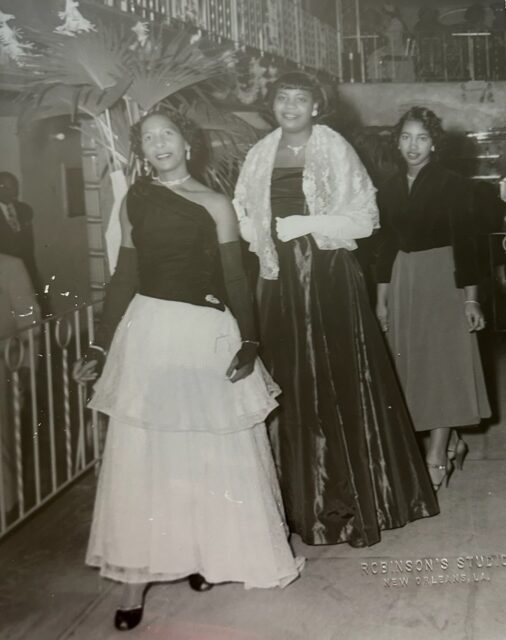“Leave Your Rought Clothes at Home”
The history and legacy of the Ninth Ward’s Law and Desire corridor
Published: February 29, 2024
Last Updated: June 1, 2024

An image of the interior of Club Desire taken during a FEMA survey in 2008 shows the ravages of both time and Hurricane Katrina.
Photo by Elizabeth Amisson, The Historic New Orleans Collection
Picture a neighborhood Frenchmen Street, only bigger, and with largely Black-owned businesses operating for Black patrons. Many of the business owners lived in the buildings in which they ran businesses or nearby. Twenty years before renowned saxophonist Roger Lewis helped found the legendary Dirty Dozen Brass Band, he played at the neighborhood crown jewel, Club Desire, in Deacon John & The Ivories as a George Washington Carver High School student. “It was a really booming strip,” he recalled of the late 1950s. “Anybody who was a hot drawing card played there.”
The area wasn’t only thriving for the sake of music. The 1956 New Orleans city directory shows no fewer than two dozen businesses within a two-block radius of Club Desire at 2604 Desire Street. Of those, at least seven were groceries or markets, six were bars or liquor stores, two were department or dry goods stores, and two others were restaurants. Throw in a pharmacy, barber, beauty supply store, service station, and more. The business names, such as Boogie Beat Bar, Anthony’s Poultry Market, Bywater Service Station, and Cat Eye Cavalry Liquor Store, evoke an era. One family name shows up often in those adjacent blocks—Armstead.
Charlie Armstead was the man with vision. He made his money in part by bootlegging alcohol during Prohibition. While running the coffee shop a block from his house, he saw the potential for a showcase music club for Black people in the days of Jim Crow segregation laws.
Dana Royster-Buefort, granddaughter of Charlie Armstead and author of the forthcoming children’s book, Happy Music: A Club Desire Story, explained that Armstead got himself snuck into New Orleans’s whites-only municipal auditorium to get ideas: “A year and a half before the club opened, he said, logistically this is what it needs to look like and have for the best sound, seating, and all that. He wanted the same kind of feel of life for the people in the Black community.”
The grand opening of Club Desire was on Mardi Gras 1948 with headliner Dave Bartholomew’s Orchestra, featuring legendary drummer Earl Palmer. The ad bills it as “ Most Modern Night Club.” Armstead wanted a classy place where you showed up dressed for a night on the town: swanky but accessible. (The grand opening ad reads in part, “leave your rought clothes at home.”)
The two-story club, with a nice restaurant that rivaled Dooky Chase, quickly became a hotspot for local and touring bands. Patrons would come from the neighborhood or take the famous streetcar named Desire to the Tonti Street stop. From there they walked three blocks to the long building where glass cubes imported from Japan surrounded the entrances.
Armstead was not only forward-thinking but also spared no expense. A sign painted on the balcony proclaimed it “The Downtown Club with Uptown Ideas.” In his autobiography, Brother Ray: Ray Charles’ Own Story, the legendary musician noted that Club Desire was the first air-conditioned club in the South. Armstead bought Fats Domino a car to persuade him to play Club Desire instead of another nearby venue (and also allowed Fats to wear overalls instead of the typical expected dress). By October of the club’s opening year, Club Desire’s Sedonia Woodson was entered into Louisiana Weekly’s first annual “Most Popular Waitress” competition for “friendly, talented, and quite ambitious” young ladies. Her sixteen competitors were from Club Robin Hood, Hotel Foster’s Rainbow Room, Rip’s Playhouse, and Curry’s Diner & Million Dollar Room, to name a few.

Patrons at Club Desire, ca. 1950s. Dana Royster-Buefort.
A few years later Armstead unexpectedly fell ill. Royster-Buefort said, “My mother Audrey had left home and gone to New York for fashion design school. When he got sick, she came back.” Up till then, Audrey hadn’t been “allowed to go into the club.” But when Armstead passed in 1954, Audrey took over. To the mix of music groups, tap artists, and exotic dancers, she added fashion shows. Those were the days of the original “for us/by us” scene, the Chitlin’ Circuit, a loose affiliation of theaters and nightclubs around the country for Black performers and Black audiences. Club Desire was listed in The Negro Travelers’ Green Book, a guidebook vouching for safe establishments for Black travelers, along with other New Orleans landmarks like the Dew Drop Inn, Shadowland, and the Caldonia Inn.
By the late 1950s, Audrey Armstead had met a young man in a blue suit at the club. His name was Roland Royster, originally from Eunice. Armstead was considering a return to New York; Royster said, “You’re not leaving me here. Let’s get married.” They did, and left together. At that point, a man named Gilbert Bell, about whom records are sparse, acquired Club Desire and took over running it in the still-flourishing Desire corridor.
Marguerite Doyle-Johnston, longtime resident and the unofficial “Mayor of Desire Street,” grew up in the 1960s a few doors from Club Desire. She described the range of businesses as “something for everyone” and recalled how exciting the energy was: “There would be a crowd of people dressed up walking from bar to bar, because they stayed open twenty-four hours. Monday to Thursday, the music was just from the jukebox, but the clubs had live music on the weekend. Sometimes I’d sit in the screened-in porch and watch people go by.”Various factors led to the area’s decline. Storm surge from Hurricane Betsy hit this part of the Upper Ninth Ward hard in 1965. The club’s second floor became a shelter from rising flood waters (a scenario that would repeat forty years later in the aftermath of Hurricane Katrina). Flood damage closed businesses along the corridor.
The Law and Desire businesses generally did not develop succession plans; as the owners got older, the shops simply closed. The only case of a nearby business branching out to the rest of the city was Bynum Pharmacy, just across the Florida Canal.
Smaller neighborhood groceries and meat markets were supplanted by supermarkets—most prominently the nearby Schwegmann Brothers Giant Supermarket on Old Gentilly Road, which was, at the time, the largest grocery store in the world, encompassing 155,000 square feet.
One unintended consequence of Civil Rights legislation was that Black consumers wanted to branch out beyond neighborhood businesses to places where they formerly weren’t welcome. “When integration came in, it pretty much killed the strip. Black people started going other places,” said Lewis.
By the seventies, the commercial footprint had thinned out; Law and Desire was mostly devoid of businesses. Club Desire meandered along for a few more decades, but its role as a venue gradually ended: when Hurricane Katrina hit and badly damaged the building, a restaurant was operating there, but the bar side was vacant.
By 2016, Club Desire was demolished. FEMA officials advocated for and sponsored a plaque stating the club’s cultural significance, but within a few years, a reckless driver hit and destroyed it. Nothing currently marks the site to note its history. The lot is empty, and traces of the area’s former vibrancy remain only in the memories of the people it served.
Michael Allen Zell is a New Orleans-based novelist, journalist, screenwriter, and playwright. His most recent book is The Last Shadow.
